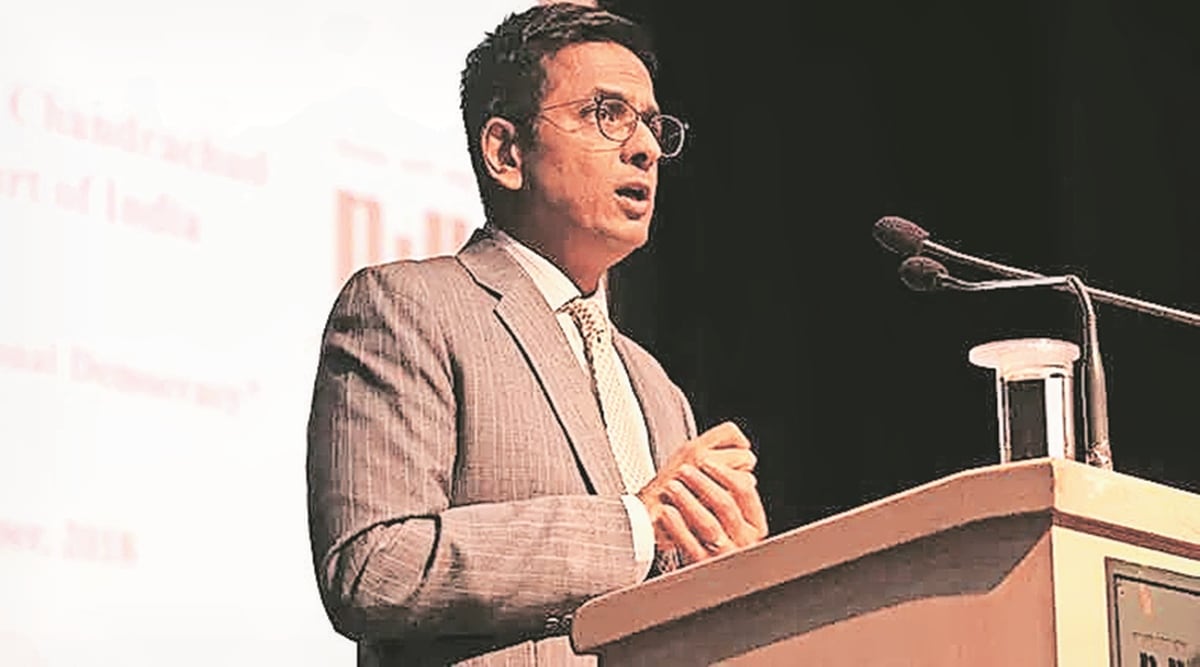 Justice Chandarchud recalled that Tuesday “also marks a special occasion, as we get a chance to celebrate the fourth anniversary" of Supreme Court’s judgment in Navtej Singh Johar vs Union of India decriminalising Section 377 of IPC. (File Photo)
Justice Chandarchud recalled that Tuesday “also marks a special occasion, as we get a chance to celebrate the fourth anniversary" of Supreme Court’s judgment in Navtej Singh Johar vs Union of India decriminalising Section 377 of IPC. (File Photo)There is still a need for “structural changes” to ensure that the “positive legal effects” of the top court’s ruling decriminalsing same-sex relations are extended to “marginalised queer people”, Supreme Court judge, Justice D Y Chandrachud, said on Tuesday.
“While decriminalisation of Section 377 has enabled queer people to emerge as legally empowered citizens and demand for their rights, rightfully and proudly, structural changes are still needed to ensure that we are able to extend these positive legal effects to marginalised queer people, who continue to face intersecting oppressions,” Justice Chandrachud said.
“Certain groups of queer people, due to their caste and class positions, are more susceptible and vulnerable to the abuse of law, both in terms of symbolic and material harm,” he said, delivering the inaugural lecture for the Office of Diversity and Inclusion at IIT- Delhi.
Justice Chandarchud recalled that Tuesday “also marks a special occasion, as we get a chance to celebrate the fourth anniversary” of Supreme Court’s judgment in Navtej Singh Johar vs Union of India decriminalising Section 377 of IPC.
On September 5, 2018, a five-judge Constitution Bench of SC had read down the provision, saying it is violative of Articles 14, 15, 19, and 21 of the Constitution insofar as it criminalises consensual sexual acts of adults in private.
Quoting from the judgement — which said that “our Constitution, above all, is an essay in the acceptance of diversity. It is founded on a vision of an inclusive society which accommodates plural ways of life” — Justice Chandrachud said, “What it signifies for all our universities and institutes of higher education is that they must look like the India they represent.”
He said, “Excellence is normally understood in ‘individual terms’, as a sign of individual merit, individual calibre, individual hard work. However, by focusing on the individual, we often mark the historically acquired privilege. Over the years, families and communities have acquired different types of capital at different levels — economic capital, cultural capital and social capital. The privileges that accrue to the so-called ‘general category’ are not limited to English-medium schooling, access to coaching centres, but also includes cultural and social capital that is inherited from their families.”
He said that “people belonging to different genders, regions, castes and socio-economic backgrounds bring in their own unique experiences, ideas, values and perspectives to bear on the task at hand by asking new questions and seeking unique solutions”.
On the aspect of diversity, he said it has “an intrinsic worth in itself, and furthers our understanding of fairness and social justice…. Innovation in science occurs when someone has the courage to ask different questions, look at problems from different perspectives, and gain new insights. Diversity results in innovative thinking and decision-making, and richness in originality of scholarly thought. Learning is impoverished when it happens in groups of like-minded people”.
Citing his own example, Justice Chandrachud said that over the years, he has had “brilliant law clerks from diverse backgrounds — from different genders, castes, classes, regions and cultural experiences — and my interactions with them continue to give me new perspectives, whether through a suggestion of a new movie or book, or by actively seeking new solutions to old problems.”
For example, he said, “my interactions with one of my clerks from the batch of 2020-21 gave me an insight into the various issues of governance that people with disabilities face in their daily lives — in our own office, we ensured that the scanned case files we received were OCR-readable; steps were undertaken to change the ‘visual captcha’ on the Supreme Court website to an audio-visual captcha, making it more accessible.”
He underlined that there is a “need to recalibrate how we understand our old vocabularies and realise that diversity and excellence actually complement and reinforce each other”, and recalled one of his earlier judgments which said, “the way we understand merit should not be limited to individual agency or ability…but it should be envisioned as a social good that advances equality because that is the value that our Constitution espouses…. Excellence, like life, is enriched by diversity.”
Justice Chandrachud said diversity “should exist at three levels: structural diversity in terms of composition of the people at the educational institution; diversity in the classrooms and the teaching resources; and interactional diversity in terms of how inclusive the higher educational institute is to facilitate interactions across diverse groups.”
“On rare occasions, when students are able to cross the structural barriers and struggle against immense odds to enter institutes of higher education, their toughest battle begins inside the institutes of higher education,” Justice Chandrachud said. “An institute which is only diverse but not inclusive imposes additional burdens on students due to their stigmatised identities.
“Instances of campus discrimination, microaggressions, social exclusion, feelings of lack of connectedness or support from peers and mentors can all have a pernicious impact on the dignity and mental health of students. Social justice cannot be restricted to access alone, but substantive inclusion is needed in higher educational institutes which promotes meaningful social and academic interactions with the larger campus community, including professors, administrators, staff and peers,” he said.